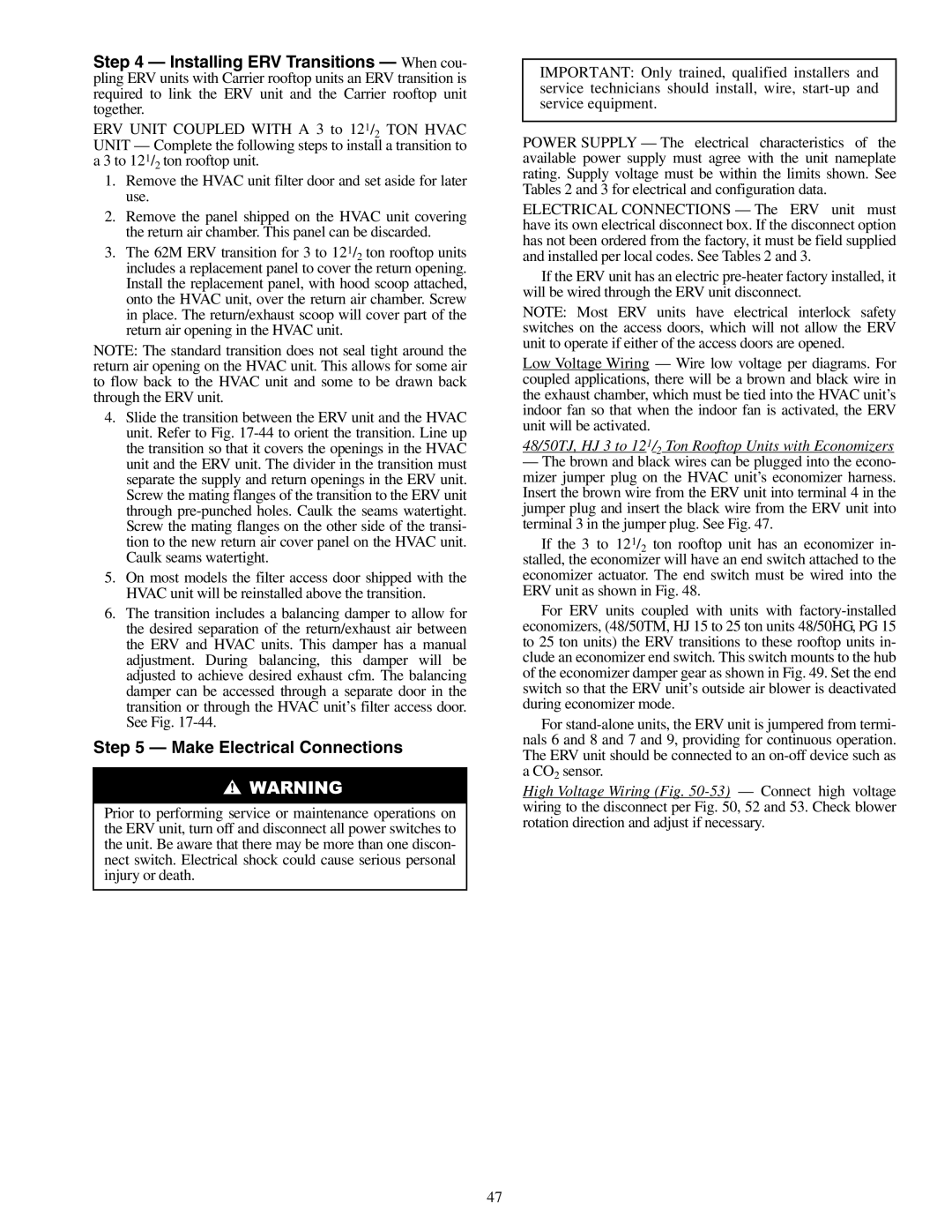
Step 4 — Installing ERV Transitions — When cou- pling ERV units with Carrier rooftop units an ERV transition is required to link the ERV unit and the Carrier rooftop unit together.
ERV UNIT COUPLED WITH A 3 to 121/2 TON HVAC UNIT — Complete the following steps to install a transition to a 3 to 121/2 ton rooftop unit.
1.Remove the HVAC unit filter door and set aside for later use.
2.Remove the panel shipped on the HVAC unit covering the return air chamber. This panel can be discarded.
3.The 62M ERV transition for 3 to 121/2 ton rooftop units includes a replacement panel to cover the return opening. Install the replacement panel, with hood scoop attached, onto the HVAC unit, over the return air chamber. Screw in place. The return/exhaust scoop will cover part of the return air opening in the HVAC unit.
NOTE: The standard transition does not seal tight around the return air opening on the HVAC unit. This allows for some air to flow back to the HVAC unit and some to be drawn back through the ERV unit.
4.Slide the transition between the ERV unit and the HVAC unit. Refer to Fig.
5.On most models the filter access door shipped with the HVAC unit will be reinstalled above the transition.
6.The transition includes a balancing damper to allow for the desired separation of the return/exhaust air between the ERV and HVAC units. This damper has a manual adjustment. During balancing, this damper will be adjusted to achieve desired exhaust cfm. The balancing damper can be accessed through a separate door in the transition or through the HVAC unit’s filter access door. See Fig.
Step 5 — Make Electrical Connections
Prior to performing service or maintenance operations on the ERV unit, turn off and disconnect all power switches to the unit. Be aware that there may be more than one discon- nect switch. Electrical shock could cause serious personal injury or death.
IMPORTANT: Only trained, qualified installers and service technicians should install, wire,
POWER SUPPLY — The electrical characteristics of the available power supply must agree with the unit nameplate rating. Supply voltage must be within the limits shown. See Tables 2 and 3 for electrical and configuration data.
ELECTRICAL CONNECTIONS — The ERV unit must have its own electrical disconnect box. If the disconnect option has not been ordered from the factory, it must be field supplied and installed per local codes. See Tables 2 and 3.
If the ERV unit has an electric
NOTE: Most ERV units have electrical interlock safety switches on the access doors, which will not allow the ERV unit to operate if either of the access doors are opened.
Low Voltage Wiring — Wire low voltage per diagrams. For coupled applications, there will be a brown and black wire in the exhaust chamber, which must be tied into the HVAC unit’s indoor fan so that when the indoor fan is activated, the ERV unit will be activated.
48/50TJ, HJ 3 to 121/2 Ton Rooftop Units with Economizers
—The brown and black wires can be plugged into the econo- mizer jumper plug on the HVAC unit’s economizer harness. Insert the brown wire from the ERV unit into terminal 4 in the jumper plug and insert the black wire from the ERV unit into terminal 3 in the jumper plug. See Fig. 47.
If the 3 to 121/2 ton rooftop unit has an economizer in- stalled, the economizer will have an end switch attached to the economizer actuator. The end switch must be wired into the ERV unit as shown in Fig. 48.
For ERV units coupled with units with
For
High Voltage Wiring (Fig.
47
